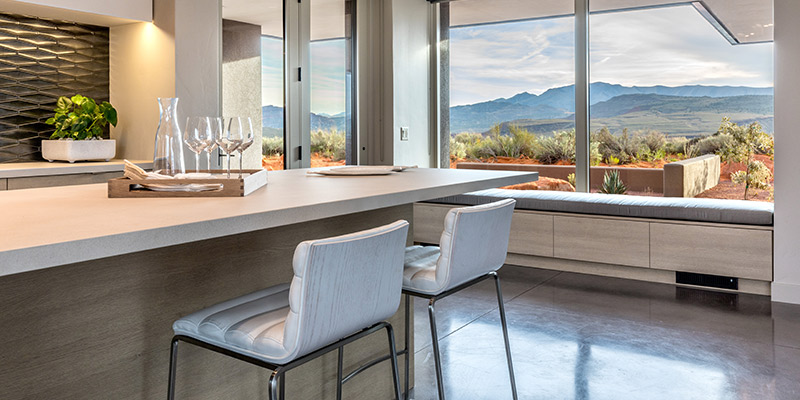
Kayenta Home Design Trends
Kayenta residents who have lived here for any length of time can’t help but be amazed by the amount of construction taking place in the community. A walk around the neighborhood, especially in the Taviawk and Posovi areas, will lead you past excavated lots; concrete mixers; wood framers; roofers; painters, window installers and landscapers, just to mention a few.
Whether your Kayenta home is five years or thirty years old, and whether you’re thinking of updating your home in anticipation of selling it or just simply curious, we thought you might be interested to learn what design trends are shaping the neighborhood and which features new homeowners are seeking most often. Matt Marten and Teresa Jacobson from Gulch Design Group recently shared their insights.
The construction of the first concept home back in 2013 created a seismic shift in the way future Kayenta homes would be constructed, due to its instant and wide appeal across all demographics. To this day, almost 8 years later, key elements of this re-imagined desert living space is influence home design locally. First was the swinging of the exterior design pendulum away from the more traditional Santa Fe-inspired look towards a more contemporized, minimalist aesthetic. Even so, the past 2-3 years have seen the construction of several stunning Southwest homes that have become instant Kayenta classics. We’re simply seeing more design diversity.
Interestingly, the majority of homes are now built with polished and sealed concrete floors (with lava gray and rawhide light brown being popular color choices), though engineered wood and tile advancements are changing this dynamic somewhat. Quartz and large format porcelain have replaced the popularity of granite when it comes to countertops.
There has also been a pronounced interest in larger garages to allow workspaces; fitness areas; etc. Detached casitas are still requested by some, disliked by others.
With recent new construction, we are seeing increased interest in both swimming pools as well as electricity-producing solar photovoltaics, with approximately 50% of new homes being installed with one or both. Conversely, interest in geothermal has declined as solar technology has advanced and become more affordable (federal tax credits have helped, though these are phasing out). Radiant heat, preferred by northerners, can still be found in some recently-built homes.
Whereas most Americans still have a preference for gas cooktops, Europeans tend to favor induction and this latter method of cooking is gaining traction in new home construction. High end appliances (Wolf; SubZero; Miele) have become increasingly popular as the size and expense of lots and new homes have climbed. Recently, up to 25% of new homes have included steam ovens in addition to or in place of microwave ovens.
Interiors are increasingly characterized by neutral light/bright colors. This applies to walls, flooring, and finishes, as people increasingly introduce color through their furnishings, accessories, and artwork instead. Speaking of cabinetry and other woodwork, the trend has been towards simpler and cleaner. Rift cut white oak and walnut remain perennial favorites with flat panel cabinets, an absence of crown molding, and baseboards painted the same color as the walls, being preferred. Color palettes tend to be limited to grays, taupe, beige, white, off white, and even “greige” (a combination of gray and beige). Bathroom and kitchen fixtures tend to be completed using bronze; brushed/satin nickel; or gold hardware.
As new homes are trending larger and larger (3,000 square feet; 3 bedrooms; 3 bathrooms; 3 car garages are becoming the Kayenta “baseline”) and emphasis is being placed increasingly on wide open panoramic views (think “large, floor to ceiling windows”), investments in automated blinds are becoming more of a practical rather than a luxury choice. Similarly, the focus on natural light has resulted in many new homes being fitted with strategically-placed skylights throughout.
Outdoors, the use of dark bronze (or natural “rust”) metal fascia continues to be a big hit at contemporizing the look of the home, as is the strategic use of natural or cut rock to accentuate key architectural features. The desert climate has led to the elimination of wood trellises and beams, which have been replaced using more durable metal. The use of materials in exterior retaining walls is dictated somewhat by the lot topography, but there seems to be an equal amount of interest in using the handcut red sandstone or exposed aggregate concrete over stucco.
If you find yourself undertaking a DIY project around the house or if you think you might be in the market to sell in the next 12-18 months, you might wish to review this article and/or contact Kayenta Homes & Properties. We’ll be pleased to discuss various ways to enhance the value of your property to meet market demands.
Please remember that remodels or any change to home exteriors will require advanced approval from the Architectural Control Committee (ACC). Visit www.kayentahoa.com for more details.


